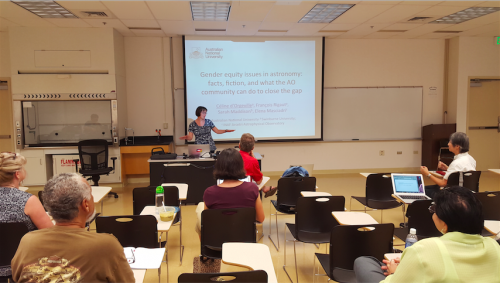- Date: 21 Oct 2015
- Comments: (0)
- Categories: For Everyone

Celine introducing her talk about Gender Equity at the University of Hawai‘i at Hilo’s Science and Technology Building.
On Monday, September 21st, former Gemini Adaptive Optics Scientist Celine d’Orgeville gave an enlightening talk titled: “Gender Equity Issues in Astronomy: Facts, Fiction, and what the Adaptive Optics Community Can Do to Close the Gap” at the Science and Technology Building at the University of Hawai‘i Hilo.
What’s Happening to Women in Academia?
While Celine conducted most of her surveys in the Adaptive Optics (AO) field, most of her research can be applied to all science, technology, engineering, and mathematics (STEM) fields. There is low representation of women in senior academic positions such as professorships. There are also gender imbalances at every level of an academic career pathway. Women that may be interested in STEM careers are lost at every educational transition. While women were originally discouraged from pursuing higher education, the US college enrollment parity was reached in 1980, meaning that there are equal numbers of men and women going to college. This supposes that there is something else that influences the gender disparity. Celine went on to address possible causes for gender disparities.
Society and Culture
Gender stereotypes and biases pervade everyday culture. For example, if someone were asked to describe a scientist, one will usually describe a white male. There’s also a “stereotype threat”, where a woman’s performance may be affected by how they are perceived or even how they perceive themselves. Everyone, male and female is implicitly (unconsciously) biased, whether they like it or not. 75% of men and women do not associate “female” with “career” as readily as “female” and “family”.
Workplace Structure and Culture
There’s a lack of family friendly policies as well as a lack of women mentors and visibility of such mentors. Nursing rooms or child care facilities are rare in most institutions, placing a burden on parents, mothers in particular. Several theories and patterns of workplace behaviors also work against women moving up in their careers.
Individual Abilities and Behaviors
Extensive studies have been conducted and there are NO differences between men and women in natural STEM abilities. It’s possible that differences in confidence levels and leadership styles between the sexes may contribute to gender disparity. Celine’s research has also shown that, in heterosexual couples, if one person were to have to relocate for work, then women would overwhelmingly follow their male counterparts, leading to gaps in or a discontinuation of their academic progress.
Women in the AO Field
Celine conducted recent surveys in the adaptive optics field, both with an institutional survey authorized by the Australian National University (ANU) Human Ethics Committee, and a self-reported survey. The institutional survey showed that the AO field has 18% female representation. The gender surveys asked questions about education background and AO discipline, employment, and family situation, and the comparisons were in percent of participants per gender. Listed are some of the results from the surveys:
- No significant gender bias in the type of degree held
- More women choose to study physics/astrophysics rather than engineering and computer science
- Men on average got their degrees earlier than women; 50% of men obtained their degrees prior to 2002, where 50% of women obtained their degrees prior to 2007
- Relatively more women (65% of those surveyed) work in astronomy than men (50% of those surveyed)
- More women at the graduate and post doc levels, but underrepresentation at the associate professor and management levels
- Men enjoy more stable employment than women, but there is equal distribution between men and women in full-time/part-time employment
- On average, women working in AO are younger than men; this seems to correlate with the year of degree distribution
- Relatively more women than men don’t have children
- Women took 3.5 times longer parental leave than men
What Can the AO Community Do to Reach for Gender Equity?
Short-term
Conference organization
- Adopt Gender Equity and Anti-harassment policies
- Monitor and publish gender demographics
- Increase female representation in invited talks and presentations
- Create and advertise a list of “women in AO”
- Provide on-site child care services or child care support to conference participants
AO institutions, departments, companies
- Create a local Gender Access and Equity Committee
- Monitor and publish gender demographics
- Adopt best practices like family-friendly meeting hours, children on-site policy, and family/parenting rooms
Long-term
Conference organization
- Repeat/refine AO gender survey
- Discuss pros/cons of author-blind abstract review
- Possibly include Gender Equity Session
AO institutions, departments, companies
- Review existing policies and perform climate surveys, then implement best practices based on the results
- Commitment to gender parity practices by those in leadership roles
- Involve students and talk about gender issues
Conclusion
Celine says that waiting for women to fill the workforce pipeline is not enough, active measures are required to encourage women to study and stay in the STEM fields. Actions to improve balance between work and home life will benefit both men and women, and more diversity in the STEM fields will benefit science and society at large.





